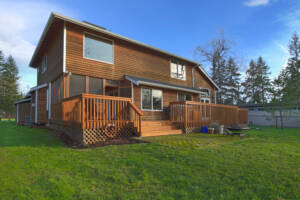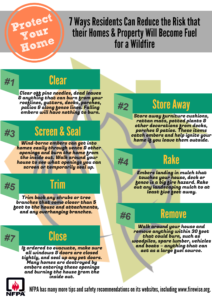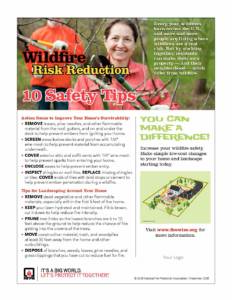Fire Resistant Decks
ATTACHED DECKS AND WILDFIRES
Warmer weather often means cookouts on the deck and gatherings with friends. But did you know that choosing the right kind of materials to build your deck and keeping it clear of combustible materials (both on the top and underneath) are critical steps in reducing the risk of a wildfire damaging your home?
Watch the video above to see how different types of decking materials and combustible materials on top of the deck performed in wildfire testing.
The vulnerability of decks to wildfire will depend on the decking board material, any combustible materials stored under the deck or kept on the deck, and the topography and amount and condition of vegetation leading to the deck. Even though noncombustible decking products are available (e.g., metal decking and lightweight concrete), many decking products are combustible. Untreated wood and wood treated with fire retardant, as well as plastic and wood-plastic composite products, are all combustible and therefore vulnerable to ember and other wildfire exposures. However, the deck can be designed to minimize exposure to embers. During fire season an important job will be to keep your deck free of easily ignited materials such as leaves and needles that have accumulated in the gaps between deck boards and at the interface between the deck and the siding of the house. Metal flashing can be applied to the lower 18 inches of the wall to protect combustible siding from the embers that may accumulate during a wildfire. It is important that the metal flashing be tucked in behind the lap-joint where it terminates. Decayed wood (rotted wood) is more readily ignited, so periodically inspect for decayed members and replace them.
 In California, deck boards on new homes now must meet a minimum performance requirement (based on energy release when burning) to be used in wildfire-prone areas. Flame spread information is usually also available for decking products. A listing of most of the decking products that comply with the California requirements is maintained in a free online database called the Building Material Listing (BML), formerly known as the WUI Product Handbook, and is maintained on the Office of the State Fire Marshal (OSFM) website.
In California, deck boards on new homes now must meet a minimum performance requirement (based on energy release when burning) to be used in wildfire-prone areas. Flame spread information is usually also available for decking products. A listing of most of the decking products that comply with the California requirements is maintained in a free online database called the Building Material Listing (BML), formerly known as the WUI Product Handbook, and is maintained on the Office of the State Fire Marshal (OSFM) website.
Some people are surprised to find that untreated wood decking is included in the Building Material Listing (BML). The testing conducted on combustible decking products has shown that most products are not highly combustible by themselves. Typically, other fuel sources contribute to larger deck fires (debris or combustible material stored under or on top of the deck, or a deck located on a slope containing a lot of combustible vegetation). The take-home message is to avoid storing other combustible materials on and under your deck. If your home is located on a slope, and your deck is overhanging it, your defensible space should be increased to avoid a flame contact exposure during a wildfire.
DECK ENCLOSURES
Regardless of what type of deck board is used, ignition can occur from an accumulation of combustible material (grass, leaves, needles) under the deck. Embers can readily ignite this debris during a fire. Enclosing the underside of the deck is one method to reduce the risk of ignition. There are two ways to enclose your deck. You can enclose it by applying sheathing or siding around the perimeter (a vertical enclosure), or by attaching sheathing/panel materials to the underside of the structural support members (a horizontal enclosure). The more careful you are about not storing combustible materials near your home (and under your deck), maintaining near-home vegetation, and cleaning up windblown debris, the less important enclosing your deck becomes.
 The closer the deck is to the ground, the harder it is to use as a storage area, but it also becomes more difficult to clean out debris that will accumulate. If you have a solid surface deck (e.g., one with a lightweight concrete walking surface), it is probably already enclosed horizontally. If you are going to store combustible materials under your deck, then vertically enclosing it with a noncombustible or ignition-resistant material would make sense. If you do this, make sure you avoid any potential moisture-related degradation issues by providing adequate venting or take other moisture control actions.
The closer the deck is to the ground, the harder it is to use as a storage area, but it also becomes more difficult to clean out debris that will accumulate. If you have a solid surface deck (e.g., one with a lightweight concrete walking surface), it is probably already enclosed horizontally. If you are going to store combustible materials under your deck, then vertically enclosing it with a noncombustible or ignition-resistant material would make sense. If you do this, make sure you avoid any potential moisture-related degradation issues by providing adequate venting or take other moisture control actions.
Deck enclosure will not guard against embers falling on top of the deck, so be aware of combustible material that you have on your deck. Firewood should be moved off of the deck during wildfire season. Combustible materials commonly found on decks (e.g., brooms, umbrellas, patio furniture, door mats, etc.) should be moved off the deck if possible, or moved as far from the building as possible during wildfires and spaced to avoid clustering items.
Resource credit: FIRESafe MARIN
Resources
- Home Survival in Wildfire-Prone Areas: Building Materials and Design Considerations: ANR Publication 8393 6
- Home Landscaping for Fire. University of California Publication 8228. 2007. University of California, Davis.
- www.readyforwildfire.org. Wildfire is Coming: Are You Ready. CAL FIRE. 2012.
- Urban Forestry Associates. Ray Moritz, Urban Forester and Fire Ecologist.
- Protecting Your Home From Wildfire. 2017. Insurance Institute for Business & Home Safety
PREPAREDNESS MENU
Prepare your Home
RESOURCES
Seven ways residents can reduce wildfire risk infographic by NFPA
Download the free wildfire safety infographic with seven tips for residents to help protect their homes in an event of a wildfire.
Wildfire risk reduction safety tips by NFPA
By working together, residents can make their own property, and their neighborhood, much safer from wildfire.


